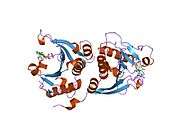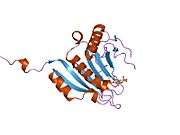EIF4E
| View/Edit Human | View/Edit Mouse |
Eukaryotic translation initiation factor 4E, also known as eIF4E, is a protein that in humans is encoded by the EIF4E gene.[3][4]
Structure and function
All eukaryotic cellular mRNAs are blocked at their 5'-ends with the 7-methyl-guanosine five-prime cap structure, m7GpppX (where X is any nucleotide). This structure is involved in several cellular processes including enhanced translational efficiency, splicing, mRNA stability, and RNA nuclear export. eIF4E is a eukaryotic translation initiation factor involved in directing ribosomes to the cap structure of mRNAs. It is a 24-kD polypeptide that exists as both a free form and as part of the eIF4F pre-initiation complex.[5] Almost all cellular mRNA require eIF4E in order to be translated into protein. The eIF4E polypeptide is the rate-limiting component of the eukaryotic translation apparatus and is involved in the mRNA-ribosome binding step of eukaryotic protein synthesis.
The other subunits of eIF4F are a 47-kD polypeptide, termed eIF4A,[6] that possesses ATPase and RNA helicase activities, and a 220-kD scaffolding polypeptide, eIF4G.[7][8][9]
Some viruses cut eIF4G in such a way that the eIF4E binding site is removed and the virus is able to translate its proteins without eIF4E. Also some cellular proteins, the most notable being heat shock proteins, do not require eIF4E in order to be translated. Both viruses and cellular proteins achieve this through an internal ribosome entry site in the RNA.
FMRP represses translation through EIF4E binding
Fragile X mental retardation protein (FMR1) acts to regulate translation of specific mRNAs through its binding of eIF4E. FMRP acts by binding CYFIP1, which directly binds eIF4e at a domain that is structurally similar to those found in 4E-BPs including EIF4EBP3, EIF4EBP1, and EIF4EBP2. The FMRP/CYFIP1 complex binds in such a way as to prevent the eIF4E-eIF4G interaction, which is necessary for translation to occur. The FMRP/CYFIP1/eIF4E interaction is strengthened by the presence of mRNA(s). In particular, BC1 RNA allows for an optimal interaction between FMRP and CYFIP1.[10] RNA-BC1 is a non-translatable, dendritic mRNA, which binds FMRP to allow for its association with a specific target mRNA. BC1 may function to regulate FMRP and mRNA interactions at synapse(s) through its recruitment of FMRP to the appropriate mRNA.[11]
In addition, FMRP may recruit CYFIP1 to specific mRNAs in order to repress translation. The FMRP-CYFIP1 translational inhibitor is regulated by stimulation of neuron(s). Increased synaptic stimulation resulted in the dissociation of eIF4E and CYFIP1, allowing for the initiation of translation.[10]
Interactions
EIF4E has been shown to interact with:
See also
References
- ↑ "Human PubMed Reference:".
- ↑ "Mouse PubMed Reference:".
- ↑ Pelletier J, Brook JD, Housman DE (August 1991). "Assignment of two of the translation initiation factor-4E (EIF4EL1 and EIF4EL2) genes to human chromosomes 4 and 20". Genomics. 10 (4): 1079–82. doi:10.1016/0888-7543(91)90203-Q. PMID 1916814.
- ↑ Jones RM, MacDonald ME, Branda J, Altherr MR, Louis DN, Schmidt EV (May 1997). "Assignment of the human gene encoding eukaryotic initiation factor 4E (EIF4E) to the region q21-25 on chromosome 4". Somatic Cell and Molecular Genetics. 23 (3): 221–223. doi:10.1007/BF02721373. PMID 9330633.
- ↑ Sonenberg N, Rupprecht KM, Hecht SM, Shatkin AJ (September 1979). "Eukaryotic mRNA cap binding protein: purification by affinity chromatography on sepharose-coupled m7GDP.". Proceedings of the National Academy of Sciences of the United States of America. 76 (9): 4345–9. doi:10.1073/pnas.76.9.4345. PMID 291969.
- ↑ Hutchins AP, Roberts GR, Lloyd CW, Doonan JH (2004). "In vivo interaction between CDKA and eIF4A: a possible mechanism linking translation and cell proliferation". FEBS Lett. 556 (1-3): 91–4. doi:10.1016/S0014-5793(03)01382-6. PMID 14706832.
- ↑ Hsieh AC, Ruggero D (11 August 2010). "Targeting Eukaryotic Translation Initiation Factor 4E (eIF4E) in Cancer". Clinical Cancer Research. 16 (20): 4914–4920. doi:10.1158/1078-0432.CCR-10-0433. PMID 20702611.
- ↑ Rychlik W, Domier LL, Gardner PR, Hellmann GM, Rhoads RE (February 1987). "Amino acid sequence of the mRNA cap-binding protein from human tissues". Proceedings of the National Academy of Sciences of the United States of America. 84 (4): 945–9. doi:10.1073/pnas.84.4.945. PMC 304336
 . PMID 3469651.
. PMID 3469651. - ↑ "Entrez Gene: eIF4E Eukaryotic translation initiation factor 4E".
- 1 2 Napoli I, Mercaldo V, Boyl PP, Eleuteri B, Zalfa F, De Rubeis S, Di Marino D, Mohr E, Massimi M, Falconi M, Witke W, Costa-Mattioli M, Sonenberg N, Achsel T, Bagni C (September 2008). "The Fragile X Syndrome Protein Represses Activity-Dependent Translation through CYFIP1, a New 4E-BP". Cell. 134 (6): 1042–1054. doi:10.1016/j.cell.2008.07.031. PMID 18805096.
- ↑ Zalfa F, Giorgi M, Primerano B, Moro A, Di Penta A, Reis S, Oostra B, Bagni C (February 2003). "The fragile X syndrome protein FMRP associates with BC1 RNA and regulates the translation of specific mRNAs at synapses". Cell. 112 (3): 317–27. doi:10.1016/S0092-8674(03)00079-5. PMID 12581522.
- 1 2 Ewing RM, Chu P, Elisma F, Li H, Taylor P, Climie S, McBroom-Cerajewski L, Robinson MD, O'Connor L, Li M, Taylor R, Dharsee M, Ho Y, Heilbut A, Moore L, Zhang S, Ornatsky O, Bukhman YV, Ethier M, Sheng Y, Vasilescu J, Abu-Farha M, Lambert JP, Duewel HS, Stewart II, Kuehl B, Hogue K, Colwill K, Gladwish K, Muskat B, Kinach R, Adams SL, Moran MF, Morin GB, Topaloglou T, Figeys D (2007). "Large-scale mapping of human protein-protein interactions by mass spectrometry". Mol. Syst. Biol. 3: 89. doi:10.1038/msb4100134. PMC 1847948
 . PMID 17353931.
. PMID 17353931. - 1 2 3 Connolly E, Braunstein S, Formenti S, Schneider RJ (May 2006). "Hypoxia inhibits protein synthesis through a 4E-BP1 and elongation factor 2 kinase pathway controlled by mTOR and uncoupled in breast cancer cells". Mol. Cell. Biol. 26 (10): 3955–65. doi:10.1128/MCB.26.10.3955-3965.2006. PMC 1489005
 . PMID 16648488.
. PMID 16648488. - ↑ Rual JF, Venkatesan K, Hao T, Hirozane-Kishikawa T, Dricot A, Li N, Berriz GF, Gibbons FD, Dreze M, Ayivi-Guedehoussou N, Klitgord N, Simon C, Boxem M, Milstein S, Rosenberg J, Goldberg DS, Zhang LV, Wong SL, Franklin G, Li S, Albala JS, Lim J, Fraughton C, Llamosas E, Cevik S, Bex C, Lamesch P, Sikorski RS, Vandenhaute J, Zoghbi HY, Smolyar A, Bosak S, Sequerra R, Doucette-Stamm L, Cusick ME, Hill DE, Roth FP, Vidal M (October 2005). "Towards a proteome-scale map of the human protein-protein interaction network". Nature. 437 (7062): 1173–8. doi:10.1038/nature04209. PMID 16189514.
- 1 2 3 Mader S, Lee H, Pause A, Sonenberg N (September 1995). "The translation initiation factor eIF-4E binds to a common motif shared by the translation factor eIF-4 gamma and the translational repressors 4E-binding proteins". Mol. Cell. Biol. 15 (9): 4990–7. PMC 230746
 . PMID 7651417.
. PMID 7651417. - ↑ Rao RD, Mladek AC, Lamont JD, Goble JM, Erlichman C, James CD, Sarkaria JN (October 2005). "Disruption of parallel and converging signaling pathways contributes to the synergistic antitumor effects of simultaneous mTOR and EGFR inhibition in GBM cells". Neoplasia. 7 (10): 921–9. doi:10.1593/neo.05361. PMC 1502028
 . PMID 16242075.
. PMID 16242075. - ↑ Eguchi S, Tokunaga C, Hidayat S, Oshiro N, Yoshino K, Kikkawa U, Yonezawa K (July 2006). "Different roles for the TOS and RAIP motifs of the translational regulator protein 4E-BP1 in the association with raptor and phosphorylation by mTOR in the regulation of cell size". Genes Cells. 11 (7): 757–66. doi:10.1111/j.1365-2443.2006.00977.x. PMID 16824195.
- ↑ Yang D, Brunn GJ, Lawrence JC (June 1999). "Mutational analysis of sites in the translational regulator, PHAS-I, that are selectively phosphorylated by mTOR". FEBS Lett. 453 (3): 387–90. doi:10.1016/s0014-5793(99)00762-0. PMID 10405182.
- ↑ Patel J, McLeod LE, Vries RG, Flynn A, Wang X, Proud CG (June 2002). "Cellular stresses profoundly inhibit protein synthesis and modulate the states of phosphorylation of multiple translation factors". Eur. J. Biochem. 269 (12): 3076–85. doi:10.1046/j.1432-1033.2002.02992.x. PMID 12071973.
- 1 2 Kumar V, Sabatini D, Pandey P, Gingras AC, Majumder PK, Kumar M, Yuan ZM, Carmichael G, Weichselbaum R, Sonenberg N, Kufe D, Kharbanda S (April 2000). "Regulation of the rapamycin and FKBP-target 1/mammalian target of rapamycin and cap-dependent initiation of translation by the c-Abl protein-tyrosine kinase". J. Biol. Chem. 275 (15): 10779–87. doi:10.1074/jbc.275.15.10779. PMID 10753870.
- ↑ Kumar V, Pandey P, Sabatini D, Kumar M, Majumder PK, Bharti A, Carmichael G, Kufe D, Kharbanda S (March 2000). "Functional interaction between RAFT1/FRAP/mTOR and protein kinase cdelta in the regulation of cap-dependent initiation of translation". EMBO J. 19 (5): 1087–97. doi:10.1093/emboj/19.5.1087. PMC 305647
 . PMID 10698949.
. PMID 10698949. - ↑ Gingras AC, Gygi SP, Raught B, Polakiewicz RD, Abraham RT, Hoekstra MF, Aebersold R, Sonenberg N (June 1999). "Regulation of 4E-BP1 phosphorylation: a novel two-step mechanism". Genes Dev. 13 (11): 1422–37. doi:10.1101/gad.13.11.1422. PMC 316780
 . PMID 10364159.
. PMID 10364159. - ↑ Shen X, Tomoo K, Uchiyama S, Kobayashi Y, Ishida T (October 2001). "Structural and thermodynamic behavior of eukaryotic initiation factor 4E in supramolecular formation with 4E-binding protein 1 and mRNA cap analogue, studied by spectroscopic methods". Chem. Pharm. Bull. 49 (10): 1299–303. doi:10.1248/cpb.49.1299. PMID 11605658.
- ↑ Adegoke OA, Chevalier S, Morais JA, Gougeon R, Kimball SR, Jefferson LS, Wing SS, Marliss EB (January 2009). "Fed-state clamp stimulates cellular mechanisms of muscle protein anabolism and modulates glucose disposal in normal men". Am. J. Physiol. Endocrinol. Metab. 296 (1): E105–13. doi:10.1152/ajpendo.90752.2008. PMC 2636991
 . PMID 18957614.
. PMID 18957614. - ↑ Pause A, Belsham GJ, Gingras AC, Donzé O, Lin TA, Lawrence JC, Sonenberg N (October 1994). "Insulin-dependent stimulation of protein synthesis by phosphorylation of a regulator of 5'-cap function". Nature. 371 (6500): 762–7. doi:10.1038/371762a0. PMID 7935836.
- ↑ Kleijn M, Scheper GC, Wilson ML, Tee AR, Proud CG (December 2002). "Localisation and regulation of the eIF4E-binding protein 4E-BP3". FEBS Lett. 532 (3): 319–23. doi:10.1016/s0014-5793(02)03694-3. PMID 12482586.
- ↑ Poulin F, Gingras AC, Olsen H, Chevalier S, Sonenberg N (May 1998). "4E-BP3, a new member of the eukaryotic initiation factor 4E-binding protein family". J. Biol. Chem. 273 (22): 14002–7. doi:10.1074/jbc.273.22.14002. PMID 9593750.
- ↑ Dostie J, Ferraiuolo M, Pause A, Adam SA, Sonenberg N (June 2000). "A novel shuttling protein, 4E-T, mediates the nuclear import of the mRNA 5' cap-binding protein, eIF4E". EMBO J. 19 (12): 3142–56. doi:10.1093/emboj/19.12.3142. PMC 203362
 . PMID 10856257.
. PMID 10856257. - ↑ Vary TC, Jefferson LS, Kimball SR (December 1999). "Amino acid-induced stimulation of translation initiation in rat skeletal muscle". Am. J. Physiol. 277 (6 Pt 1): E1077–86. PMID 10600798.
- ↑ Harris TE, Chi A, Shabanowitz J, Hunt DF, Rhoads RE, Lawrence JC (April 2006). "mTOR-dependent stimulation of the association of eIF4G and eIF3 by insulin". EMBO J. 25 (8): 1659–68. doi:10.1038/sj.emboj.7601047. PMC 1440840
 . PMID 16541103.
. PMID 16541103. - ↑ Gradi A, Imataka H, Svitkin YV, Rom E, Raught B, Morino S, Sonenberg N (January 1998). "A novel functional human eukaryotic translation initiation factor 4G". Mol. Cell. Biol. 18 (1): 334–42. doi:10.1128/mcb.18.1.334. PMC 121501
 . PMID 9418880.
. PMID 9418880.
Further reading
- Jain S, Khuri FR, Shin DM (2004). "Prevention of head and neck cancer: current status and future prospects". Current Problems in Cancer. 28 (5): 265–86. doi:10.1016/j.currproblcancer.2004.05.003. PMID 15375804.
- Culjkovic B, Topisirovic I, Borden KL (2007). "Controlling gene expression through RNA regulons: the role of the eukaryotic translation initiation factor eIF4E". Cell Cycle. 6 (1): 65–9. doi:10.4161/cc.6.1.3688. PMID 17245113.
- Malys N, McCarthy JE (2010). "Translation initiation: variations in the mechanism can be anticipated". Cellular and Molecular Life Sciences. 68 (6): 991–1003. doi:10.1007/s00018-010-0588-z. PMID 21076851.
External links
- Cap-dependent translation initiation from Nature Reviews Microbiology. A good image and overview of the function of initiation factors.
This article incorporates text from the United States National Library of Medicine, which is in the public domain.











